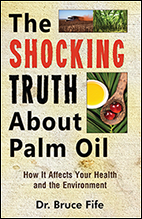E-Mail Edition Volume 13 Number 2
Published Winter, 2016
Published by Piccadilly Books, Ltd., www.piccadillybooks.com.
Bruce Fife, N.D., Publisher, http://www.coconutresearchcenter.org/
If you would like to subscribe to the
Healthy Ways Newsletter
Contents:
-
Are Genetically Engineered Foods the Wave of the Future?
-
Environmental and Health Hazards of Roundup
-
The Truth about Palm Oil and the Environment
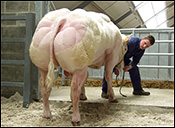
Genetically Modified Bull
Are Genetically Engineered Foods the Wave of the Future?
What
You Should Know About the Foods You Eat
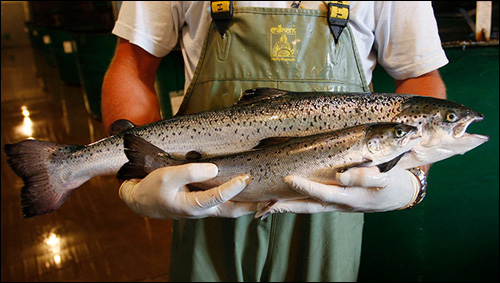
GE salmon have genes from a Chinook salmon and an ocean pout—a type of eel—that make more than the usual dose of growth hormone, so they reach market size in half the time as natural salmon. A genetically engineered salmon from AquaBounty Technologies, rear, with a conventionally raised sibling roughly the same age.
The
United States Food and Drug Administration (FDA) recently
announced that it has approved the sale of genetically
engineered (GE) salmon for human consumption, making it the
first genetically altered animal to be cleared for sale in
supermarkets and restaurants. The genetically altered salmon are
engineered to produce a higher level of growth hormone, causing
them to reach market size in just half the time as
conventionally raised salmon.
More
GE foods are on the way. Korean scientists have developed hogs
with extraordinarily large backsides, the part that pork-eaters
particularly value. These grotesque-looking hogs resemble
something you might imagine from creepy offspring of animals
exposed to high levels of radiation more than they do potential
sources of food for human consumption. Their appearance is
enough to turn anybody’s stomach.
Developing animals that produce a greater percentage of prime cuts of meat is a major goal of genetic scientists. However, not all of the genetic manipulations are focused on producing larger animals or animals with grossly expanded body parts. Some animals are developed to enhance or remove certain characteristics. Researchers in Minnesota are developing milk and beef cattle
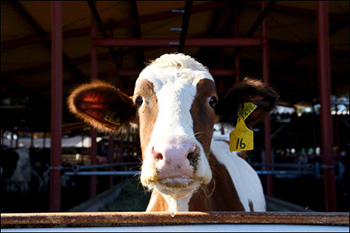
Hornless Cow
that have no
horns. Ranchers typically de-horn cattle when they are calves to make
them less likely to inure other animals or the people who handle them.
One drawback so far with hornless dairy cows is it that they don’t
produce any milk, just another glitch to be worked out with further
genetic manipulations. In New Zealand scientists have engineered cows
that produce milk without the proteins that trigger milk allergies; now
everyone can enjoy GE milk.
Even insects
are being genetically manipulated. Genetically altered mosquitoes will
soon be released in the Florida Keys as an attempt to reduce the risk of
dengue fever. There is no guarantee that this experiment will work.
Introducing species of animals and insects from one part of the world
into other areas to control pests has generally ended up as
environmental disasters. A genetically altered insect is foreign to the
entire world so there is no telling what might happen.
Farmers have
been using GE crops since the 1990s. Currently as much as 80 percent of
the foods in the typical American grocery store contain GE ingredients.
Proponents of GE foods claim that they are the wave of the future and
will increase crop yields and provide a means to feed a growing world
population and thus end world hunger. A noble cause indeed, but is it
true? Will converting conventional crops to GE varieties end world
hunger? Will it even increase crop yields? Or, as some critics claim,
will it be a colossal failure or even worse, usher in an environmental
catastrophe and economic disaster?
We hear a lot
about the potential harm caused by consuming gluten, sugar, artificial
sweeteners, trans fats, preservatives, and such. Of all the ingredients
in our foods, what ones are potentially the most troubling? While all of
those mentioned have their issues, potentially the most troubling foods
are those that contain GE or genetically modified (GM) ingredients. Not
only do they pose a threat to our health, but they are dangerous to the
environment. What makes them especially troubling is the fact that in
places like the US, there are no labeling laws to inform you which foods
contain GE ingredients.
The biotech
firms that produce GE seeds, the Grocery Manufacturers Association (a
consortium of food producers and manufactures) and their friends in
government are continually telling us that GE foods are completely safe
and there is no need to worry. Thus, causing many people to be in a
state of ignorance about the real dangers of these foods.
Awareness
about the potential risks of genetically engineered foods is growing.
This is due largely because of the publicity generated by individual
states that have put to vote whether or not to require foods that
contain GE ingredients be identified on the label. Giant corporations
and their associates like Monsanto, (and other biotech companies) and
the Grocery Manufacturers Association, have been fighting bitterly to
prevent consumers from knowing what’s in their foods. The latest polls
suggest more than 90 percent of Americans now want to know what’s in
their foods (according to a poll conducted by MSNBC).
A number of
scientists have raised warnings about the danger of GE foods. The
evidence is strong enough to convince many governments to ban them or at
least establish labeling laws so their citizens know what they are
buying. Currently 64 nations require the labeling of foods containing GE
ingredients including Austria, Germany, Switzerland, Italy, New Zealand,
Australia, Greece, Poland, Malaysia, Brazil, Russia, India, and even
China.
Most Americans
are totally unaware that they are already eating GE foods. There are no
labeling laws at present to inform them. Since the 1990s GE foods have
slowly and quietly filtered into our food system. Today, approximately
80 percent of the foods sold in stores and restaurants contain at least
some GE ingredients.
About 90
percent of all corn, soybeans, rapeseed/canola, sugar beets, and cotton
grown in the US are genetically altered. If you eat anything that
contains these foods you are most likely eating GE products. You say you
don’t eat corn or soy. Think again. Corn is in almost everything. Corn
is used in corn meal and flour, oil, and high fructose corn syrup. How
many products are cooked in corn oil or contain high fructose corn
syrup? Lots! Most foods now are sweetened with high fructose corn
syrup—cakes, cookies, ice cream, candy, ketchup, salad dressing,
bread,...the list can go on and on. Likewise with soy. Soybean oil is
found everywhere. It is one of the most common cooking oils, especially
hydrogenated soybean oil which is used extensively in restaurants and
for all types of prepared foods. Like corn, soy in one form or another
is found in thousands of consumer products. Canola oil is also widely
used in food production and restaurants. With the awareness of the
dangers of trans fats from hydrogenated oils, many food producers are
turning to canola oil instead. Look at the multitude of the foods that
contain sugar. The source of that sugar is most likely GE sugar beets.
What about cotton? We don’t eat that right? Wrong! Cottonseed oil is a
major source of hydrogenated oil used in the food industry. All of these
GE crops are also used to feed livestock. The chicken, beef, pork, and
even fish we buy at the store are often raised on GE crops. In addition,
we are also exposed to GE wheat, squash, papaya, and other foods.
Genetic
Engineering is an Imprecise Science
Trying to
control genetic changes through artificial modification is a dangerous
game. It is dangerous because it enables genes to be transferred between
species that would never be possible otherwise. Genetic modification
involves injecting a gene from one species of plant or animal into a
completely different and naturally incompatible species, yielding
unexpected and often unpredictable results.
Much of the
genetic research that is going on is hidden from the public because
biotech firms require their employees sign legally binding secrecy
agreements that forbid them from talking about their research with
anyone.
According to
geneticist Dr Jonathan Latham, who published an independent study on GE
plants, genetic engineering is very imprecise and is making a mess of
plant genomes. The process causes unexpected gene mutations and DNA
damage. Most GE plants contain more than one genetic modification, some
of the plants his team evaluated had as many as 40 different foreign
genes in them.1 Latham says that some of the gene
combinations in commercially available plants are so complex that even
the biotech companies have given up on trying to assess the potential
damage done the plant’s DNA. In other words, even the scientists don’t
know what they are creating, let alone what effect they will have on our
health and the environment.
The insertion
of plant, animal, bacterial, and viral genes in food crops can lead to
unpredictable and uncontrollable results. Examples of unforeseen changes
witnessed in GE foods include poor crop performance, altered nutritional
content, increased levels of toxins and allergens in foods, and
potential harm to the environment and ecosystems.
Genetic
engineering of food crops are designed specifically to be resistant to
herbicides (such as Monsanto’s weed killer Roundup), be resistant to
certain pests, or to produce their own insecticide to discourage insect
damage. Herbicide resistant crops can withstand exposure to huge doses
of chemical weed killers without harm, while indigenous plants nearby
wither and die. Plants designed to produce their own toxic chemicals
supplement chemical sprays to keep insects at bay. GE crops can contain
multiple genetic alternations so that they are resistant to several
types of herbicides and produce their own insecticides. Sounds
appetizing doesn’t it?
As of yet, GE
crops are not designed to produce larger plants or be more productive.
It’s all about managing pests.
Differences in
GE and Non-GE Plants
Biotech
companies claim that GE crops are no different from conventional crops
in nutritional quality and safety. The claim that GE foods are
materially comparable to conventional foods, and therefore inherently
safe, is false when you consider GE crops are designed to be different.
A recent study
published in the journal Food
Chemistry reveals that there are distinct differences.2
The researchers analyzed soybeans produced under three separate
conditions: (1) genetically modified, glyphosate-tolerant soy, (2)
unmodified soy cultivated using a conventional chemical cultivation
regime, and (3) unmodified soy produced using an organic cultivation
regime.
The
researchers stated, "Using 35 different nutritional and elemental
variables to characterize each soy sample, we were able to discriminate
GM, conventional, and organic soybeans
without exception,
demonstrating substantial
non-equivalence in compositional characteristics for ready-to-market
soybeans.” GE soybeans actually had a reduced level of important
nutrients and therefore, were less nutritious than conventional
soybeans.
Roundup Ready
cops are engineered to withstand exposure to massive doses that would
normally kill the plant as well as all surrounding vegetation. As a
consequence, GE crops are heavily sprayed, much more so than
conventional crops. Even if the nutritional levels were the same, the
high level of spraying makes the GE crops less healthful simply because
they contain a much higher level of herbicide residue.
Plants that
are sprayed with herbicides and insecticides can be taken home and
washed or peeled to make them safer because most of the chemical residue
clings to the surface of the food.
However, with
GE plants, you can’t wash out the insecticides that have been placed
there genetically because it is in every cell of the plant. It is in
what you eat.
Over 37
percent of the GE crops have stacked genes.—two or more GE genes
inserted into them. So the plant is not just resistance to Roundup but
to other herbicides and may also contain genes to produce their own
insecticides. These are the types of GE foods we and the animals in our
food supply are being fed.
Environmental
Effect
One of the
purposes of GE crops is so that more herbicides can be sprayed on them
to annihilate all other plants. Herbicides are designed to kill native
plants. Tons of herbicides and insecticides are sprayed on farms around
the world. Winds, water, rain, and insects spread them throughout the
environment, into the soil and water wreaking havoc wherever they go—it
doesn’t take a genius to see the tremendous damage these poisons pose to
the environment.
With the
advent of Roundup Ready crops, use of glyphosate (the active ingredient
in Roundup) has significantly risen with about 1 billion pounds sprayed
on crops every year. That’s 1 billion pounds of herbicide released into
the environment annually just from this one product.
Glyphosate’s
toxicity is well established, with adverse health effects ranging from
birth defects to endocrine dysfunction to cancer.3 Glyphosate
is classified as a Class 2A "probable human carcinogen” by the
International Agency for Research on Cancer (IARC), a division of the
World Health Organization (WHO).
Unbelievably,
the US Department of Agriculture (USDA) admits foods are not tested for
glyphosate residues due to the high cost of doing such tests. GE crops
are heavily contaminated with glyphosate, much more so than conventional
crops; this fact alone blows a massive hole in the safety claim.
The increased
use of Roundup has caused glyphosate–resistant super weeds to
proliferate, leading to a greater use of the herbicides and greater harm
to the environment. Current GE crops are being replaced with new
varieties that can withstand even heavier doses of herbicides.
Despite the
mounting evidence questioning glyphosate’s safety, the Environmental
Protection Agency (EPA) raised the allowable limits of glyphosate in our
food and feed crops. Allowable levels in oilseed crops, such as soy and
canola, have been doubled from 20 ppm to 40 ppm. Permissible glyphosate
levels in many other foods have been raised by 15 to 25 times previous
levels. Root and tuber vegetables got one of the largest boosts, with
allowable residue limits being raised form 0.2 ppm to 6.0 ppm. Crops fed
to livestock can have much higher levels, up to 400 ppm or more. All GE
crops have glyphosate residue. When you eat GE foods, you really can’t
divorce the fact that you’re also eating glyphosate.
Pesticides and herbicides kill more than just noxious pests, they destroy wildlife that is essential for a healthy environment and food supply. For example, with the increased use of GE crops and massive spraying, Monarch butterfly and honey bee populations have been decimated in the US. It has been estimated that in some areas of the country there has been an 80 percent decline in these important insects within the past few years. This might not sound too alarming, until you consider the impact the absence of just these two insects can have on our lives. Monarch butterflies are pollinators, which makes them important for plant

Monarch Butterfly
reproduction.
They also provide an essential food source for small birds and other
animals, which feed larger birds and animals. Monarchs play an important
role in ecosystem health and biodiversity. Honey bees too, are
pollinators, very important pollinators. Bees are essential for the
pollination of numerous flowering plants and food crops. Without them we
would lose at least one-third of all our fruits, nuts, and vegetables.
It’s not just Monarchs and bees that are adversely affected by chemical
sprays, but literally millions of insects, animals, and plants as well
as humans are harmed by them.
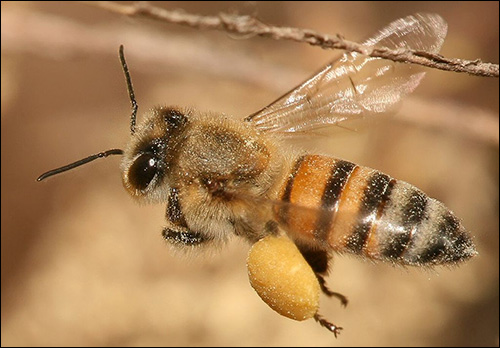
Honey Bee
Nearly one billion pounds of Roundup herbicide
is used each year for conventional crop production. Genetically
engineered crops are more heavily sprayed, since the so-called Roundup
Ready crops are designed to withstand lethal doses of this chemical,
thus increasing the potential harm to the environment. And that is not
to mention all of the other herbicides and pesticides that are also used
in agriculture.
Plight of the Monarch Video
Soil is the living
skin of the earth. Soil is a combination of granulated rock, water, organic
matter, and microbes—bacteria, protozoa, fungi, nematodes, and arthropods.
One tablespoon of soil contains about 50 billion living organisms. These
microorganisms are key in making nutrients available to plants. The
nitrogen, potassium, phosphate, calcium, magnesium, and other essential
elements are released into the soil by the activity of microorganisms on
rocks and organic matter in the soil. Without this great diversity of living
creatures in the soil, plants could not exist. Soil organisms are vital to
plant health.
Part of what makes
fruits and vegetables good for us are the phytonutrients—plant derived
nutrients that help protect us from high blood pressure, glaucoma, cancer,
premature aging, and other health problems. Phytonutrients are part of the
plant’s immune system. Organisms in the soil that we might think of as pests
actually stimulate plants to make more phytonutrients. So these small
stressors actually, in a sense, enhance our health. Being exposed to
different organisms improves the health of the plant and improves our health
as well.
Pesticides and
other agrichemicals not only kill insects but also the beneficial soil
microorganisms, degrading soil quality and fertility. This creates a need to
use chemical fertilizers, which can cause more harm by further altering the
normal soil ecology, making plants more susceptible to disease and pests.
This in turn, prompts the use of more agrichemicals and the further
reduction of soil productivity, which encourages the use of more chemical
fertilizers. The cycle continues, making the soils less and less productive.
Genetic
engineering affects livestock as well. GE plants contain their own
insecticides to discourage insects and animals from eating them. Farm
animals don’t like them either and won’t touch them if given the choice.
Livestock won’t eat them unless they are forced to. When GE feed is all that
is available, livestock learn to tolerate it or starve. This is just another
form of animal cruelty.
When GE crops are
planted, there is nothing to prevent the seeds and pollen from being washed
or blown to neighboring farms where they can contaminate non-GE crops. What
will happen if they crossbreed with native plants? Will the GE gene be
passed on? Will heavy spraying cause genetic adaptations in native plants
and animals? This has already resulted in the creation of super weeds and
super bugs that can withstand pesticide sprays. What will be next?
Will Not Eliminate
Hunger
The number one
argument and justification for GE crops is the claim that they are needed to
prevent starvation and feed the billions of people in the world. Proponents
claim GE foods are necessary to feed the world’s starving children. Who
wouldn’t want to do that, right? It’s enough to make you want to cry, not
because the biotech firms are so benevolent, but because there are people
who actually believe this pile of baloney. The one and only reason for GE
foods is for profit, pure and simple. There is no intrinsic desire to feed
starving people. Their blatant disregard for the health and welfare of
people, animals, and the environment is obvious in their refusal to do
proper safety and environmental studies and their opposition to independent
researchers to do such studies. It is also evident in their fierce
opposition to labeling of food and their aggressive persecution of farmers
who save GE seeds, as they must purchase new seeds annually or face a
lawsuit for patent infringement.
The claim that GE
crops will eliminate world hunger conveys the idea that they produce a
higher yield than conventional crops. However, this is not true. There is no
gene in the plants to make them more productive and they are no better than
conventional crops at tolerating poor soils or unstable climate conditions.
The claim is based solely on the assumption that yields will be better
because GE crops are more resistance to herbicides and to bugs eating them.
GE crops have been
around for two decades now, if they are going to save the world from
starvation, we would already have seen some evidence of that by now, but we
haven’t. Pesticides that are required on GE crops poison the soil, kill
wildlife, and wreak havoc on the ecosystem contributing to the gradual
destruction and loss of productive farmland. This would be a disaster if GE
crops were grown around the world.
Most people
worldwide simply don’t want to eat genetically altered foods. As a result,
US exports of soy and corn have declined by as much as $300 million per year
just from the lost to European exports alone. Corn exports to China dropped
85 percent from 2013 to 1014. How can GE foods feed the world if the world
doesn’t want to eat them?
Not Proven Safe
Genetic
modification of foods has never proven to be safe for humans or the
environment. Assessments on safety come only from the biotech corporations
themselves, the same companies that profit from these positive safety
studies.
Safety studies
performed on GE crops fed to animals have generally looked at things such as
milk production and meat yield, outcomes that are not relevant to human
health. These studies generally do not examine tissues or organs in the
animals or look at the biochemistry to identify disease or abnormalities.
They are production studies. The vast majority of studies are done to
reassure the producers that GE fed animals will live long enough to produce
a good yield when they are mature enough to take to market.
There have been
very few published studies actually using GE feed. Instead of feeding the
test animals GE feed, they just give them the particular proteins the
altered plants are suppose to produce. These studies are done using rats.
The number of rats used in the studies are too few to produce any real
statistically meaningful data. They’ll usually observe the rats for only 7
to 14 days, and rarely up to 3 months, and see if the rats die. If they
don’t, then the GE food containing the protein is declared safe for human
consumption regardless of how long or how much a human might consume. We are
expected to eat these foods for years, for our entire lives, not just a few
days or weeks. However, these proteins, which may come from plants, bacteria,
viruses, or animals, can have unknown effects when injected into an entirely
different species. There are no long term studies that actually test GE
foods. These so-called "safety” studies are used to justify the claim that
GE foods are safe for us to eat for an entire lifetime, from birth to death.
No additional studies are needed and, therefore, independent researchers
need not bother attempting such studies. Consequently, GE seeds are off
limits to them. Outside researchers can’t even repeat these studies to
verify the results.
Another
potentially serious consequence of GE foods that has not been investigated
is the effect of feeding more than one variety of GE plant. If your diet
contains GE corn and soy you could be getting two or more different GE
genes. Even a single plant, like corn, can contain more than one foreign
gene. The effects of these multiple foreign genes can have a significant
effect. In medicine this is referred to polypharmacy—the simultaneous use of
two or more drugs.
For example, if
you feed somebody an aspirin, the side effects might be so minor it is of
little concern. However, if you feed that person another drug at the same
time, the two drugs can interact to have very serious consequences. The same
can be true with GE foods. We don’t know because there have not been any
such studies.
Very few real
safety studies have been done, primarily because of the difficulty of
obtaining GE seeds to study. It is nearly impossible for an independent
researcher to get GE seeds to verify the results or to make any meaningful
investigation.
Independent
researchers who wish to do GE studies are forbidden to use GE crops. It is
almost impossible for an independent researcher to obtain GE seeds to do
safety studies not authorized or funded (i.e., controlled) by the biotech
companies. GE seeds are protected by patent laws. You can’t simply go down
to your local garden store and purchase the seeds. You must get them
directly from the biotech companies. Farmers or anyone else who buys the
seeds are required to sign a technology user agreement, which obligates the
buyer not do any research on the seeds or give the seeds to anyone else to
do research. Such precautions make you wonder why the biotech companies are
so afraid of having independent research on their products, are they trying
to hide something?
Health Dangers of
GE Foods
Genetic
engineering is not as precise or as accurate as it is generally believed.
The genes from foreign organisms are not carefully inserted into the host’s
DNA at precise locations for optimal function. When scientists inject the
gene into the host, they have no control over where the gene may end up on
the host’s DNA. This is a potentially serious situation as the position the
genes occur on the DNA strand can be important. In other words, genetic
engineering is like playing Russian Roulette. You don’t know what your
results will be. The seeds developed from GE may live, and develop much like
an ordinary plant, but the chemical changes within the plant are really
unknown and could have far reaching effects on our health, especially if
they are eaten over a lifetime.
These chemical
changes can alter the nutritional content, effect enzyme structure and
activity, and produce various compounds that could be toxic. Many plants
produce natural toxins to discourage predators (bugs and animals) from
eating them. Ordinarily, we can tolerate a small amount of these toxins, an
unnatural gene can possibly alter them causing them to be more toxic or more
abundant in the plant and thus, harmful for humans and animals. The foreign
gene could cause totally new chemicals to be created that could have drastic
effects on our health and the health of the environment. Genetic engineering
of our foods is really a massive experiment on the human population. We
don’t know all the dangers. However, some alarming facts have been
uncovered.
Despite the
difficulties of independent researchers studying GE foods, a very small
handful of studies have been done, with alarming results.
One of the first
indications that GE foods might be harmful came from the observations of
Howard Vlieger, a crop and livestock nutrition advisor.4 His
first experience with genetically modified organisms (GMOs) came in 1997
when he planted a test plot comparing GE corn to the conventional version.
He had heard from farmers in Nebraska that cows shied away from the GE corn.
So he gave his cows the choice to consume the conventionally grown corn or
GE corn. His cows ate the conventionally grown, however they smelled the GE
corn and walked away from it. It’s not normal for hungry cattle to refuse
food. He has tried this with many other animals and found that if they have
not been forced to consume GE food in the past, they won't eat it and will
go for the conventional feed instead.
In his role as a
crop and livestock nutrition adviser, Vlieger knew other farmers who were
feeding their animals GE feed. In South Dakota, a farmer fed his sows GE
corn and they had on average 1.6 less piglets per litter. The piglets also
weighed less at birth.
A farmer from
Harlan, Iowa, had sows with pseudo pregnancies. They seemed to be pregnant,
but when they delivered, there was only a sack of water, afterbirth, and no
pigs. The Farm Bureau Spokesman wrote about this farmer's travails and he
got calls from other farmers saying they were having the same problem.
Interestingly, they were all using the same GE corn. Iowa State University
claimed not to find any connection between the GE corn and fertility, but
when the farmers stopped using that form of GE corn and switched to
conventional corn, the problem disappeared.
Vlieger worked
with a hog operation in Nebraska which used GE corn in the feed of breeding
animals and found conception rates drop 30 percent. The local vet came out
and tested the feed for mycotoxins and mold, but did not find any. The next
group of sows was fed conventional corn and conception rates jumped back up
to about 90 percent. They switched back to GE corn and conception rates
dropped again, this time down by 70 percent.
In Iowa, farmers
found anemia and gastrointestinal tract problems such as ileitis
(inflammation of the small intestine), bloody bowel, ulcers, and salmonella.
When GE corn was taken out of the feed, the problems went away.
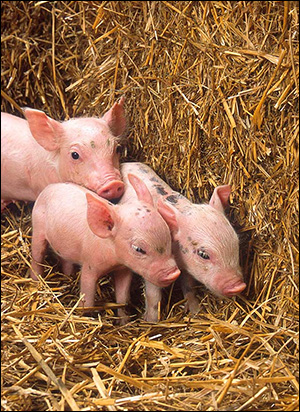
Babby Piglets
If GMOs are
causing stomach and gastrointestinal inflammation, bloody bowel, ileitis,
infertility, ulcers, and false pregnancies in farm animals,
what are they doing to us?
Since
glyphosate,
which is on all GE crops, kills the bacteria in the soil, what does it do to
the bacteria inside our bodies and to the environment inside our gastrointestinal tract?
Vlieger’s observations
sparked Judy Carman, PhD to do an in-depth study with pigs to see if the
farmer’s experiences were truly related to consuming GE crops. Dr. Carman
is an
adjunct associate professor at Flinders University in South Australia and
the director of the Institute of Health and Environmental Research.5
Pigs have a very
similar digestive system to humans and what is seen in them when they eat GE
foods will likely be found in humans. She wanted to do a proper study with
enough pigs to have a statistical significance and for a long enough time to
be meaningful. Her first obstacle to overcome was legally obtaining GE
seeds. The biotech companies would not sell them to her for her study so she
had to devise a means to get them another way. After a great deal of effort,
she was able to acquire seeds legally for her study. She declines to reveal
how she obtained the seeds because she does not want that loophole to be
plugged.
She and her
colleagues obtained piglets as soon as they were weaned. The first solid
food they were given was either GE or non-GE. The pigs were fed for their
entire commercial lifespan. This was a commercial piggery study, it was done
under commercial piggery conditions. The animals, once they reached 5 months
were processed according to industry standards. So the pigs were exposed to
the GE feed for less than 5 months.
Unlike industry
sponsored studies that use only a handful of rats, she used a total of 168
pigs in her study, enough to derive some statistical significance in the
results.
Carman’s study
found many of the same problems reported by Vlieger. There was a
significant increase in stomach inflammation in the pigs—severe
inflammation. "When I say ‘severe,’ I’m talking about a stomach that is
swollen and cherry red in color over almost the entire surface of the
stomach,” says Carman. "This is not the sort of stomach that you or I would
want to have at all.”
They next looked
at reproductive health. They couldn’t examine male reproductive health
because all the boars were neutered at 3 days of age. But they could examine
the female pigs. They found
an abnormal thickening of
the uterus in
the pigs fed GE
food. The uterus was 25 percent heavier. In the paper they talk about all of
the disease states that this could represent.6
Your body houses
some 100 trillion bacteria. You have more bacteria in your body than you
have cells, 10 times more. In essence, we are a colony of microbes. These
organisms are not simply freeloaders feeding off our bodies, but work in
harmony with our bodies performing a wide variety of important functions
essential for good health. The type of bacteria in your gastrointestinal
(GI) tract is just as important as your own cells for proper digestive
function. Some bacteria produce essential vitamins for us, other help us
digest foods or strengthen our immune system. Some microbes, including
viruses and yeasts, can be harmful and wreak havoc on our bodies if their
numbers get out of hand. Having large populations of so-called "friendly”
bacteria prevent the overgrowth of potentially harmful microbes. Without
these tiny organisms we could not exist, with the wrong type we become prone
to malnutrition and disease. Having the right proportions of the different
bacteria and other microbes helps keep us healthy.
One of the very
serious dangers of GE crops is the alteration of the gut microbiota—the
microorganisms living in your GI tract. The studies by Howard Vlieger and
Judy Carman demonstrated that diets containing GM foods lead to severe GI
inflammation and damage. While it is possible that something in the GM foods
could be irritating the GI tract causing these conditions, another
possibility is that the high percentage of glyphosate residue on these foods
is causing it. We know glyphosate kills soil bacteria, why not gut bacteria
as well? These GE chemicals and herbicides could be killing the beneficial
gut bacteria, allowing more virulent strains to proliferate, creating an
environment in the gut leading to inflammation, leaky gut, ulcers, bleeding,
immune disorders, allergies, nutrient malabsorption, and reduced nutrient
syntheses, among other things.
Another rare study
by an independent researcher was conducted by Dr. Gilles-Eric Seralini. He
replicated the studies that the industry used to establish the safety of the
GE foods. But rather than terminating the study at three months or less, he
took it to two years, which is the typical life expectancy of a rat. In
order to obtain statistical significance, Seralini’s study included 200
rats, unlike the typical 10 or 20 used in biotech supported studies.
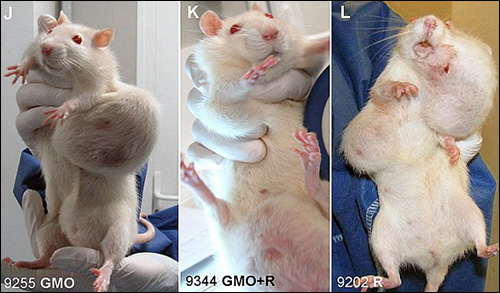
Rats with tumors from genetic enginering.
There were some
very significant differences between Seralini’s study and the previous
industry-sponsored studies. Rats fed GE food their entire lives developed
huge breast tumors and suffered from liver and kidney damage. As much as 80
percent of the female rats developed large tumors by the beginning of the 24th
month, with up to three tumors per animal. Up to 70 percent of female rats
died prematurely. Large tumors began to appear after only seven months.
However, the
majority of tumors were detectable only after 18 months, meaning they could
be discovered only in long-term feeding trials.
Since GE foods are
always contaminated with residual glyphosate the effect may possibly have
been due to the herbicide rather than the genetic alternation. To identify
this possibility Seralini separated the rats into groups. He had some rats
fed the GE and non-GE foods without glyphosate contamination, and others
were fed foods sprayed with glyphosate. He found that there were problems
with animals fed the glyphosate and those fed the non-sprayed GE food, but
when you put the two of them together, the effects were worse.7
Digestive
disorders are becoming rampant—sensitivity to wheat and gluten, celiac
disease, food allergies, Crohn’s, colitis, and GERD. Such conditions appear
to be epidemic. Food allergies are becoming more common. Reproductive health
is becoming a growing concern. Infertility, miscarriages, premature births,
cesarean deliveries, birth defects, and childhood developmental disorders
are at an all time high. Cancer is the second leading cause of death. We’ve
been at war with cancer for over 40 years and are losing the battle. Are GE
crops and pesticides to blame? Until the biotech companies allow independent
researchers to do meaningful safety studies we won’t know for sure, but the
evidence so far suggest it may be so.
In the meantime,
we can support efforts to label GE foods so that we know what we are buying
at the store. At this point, the only guarantee that your food is safe is to
buy and eat organically raised foods.
Watch Genetic
Roulette Movie
click here

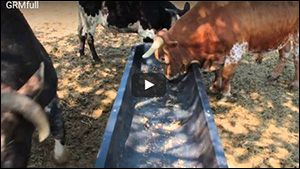
References
1. Latham, JR, et
al. Transformation-induced mutations in transgenic plants: analysis and
biosafety implications. Biotechnol Genet Eng Rev 2006;23:209-237.
2. Bohn, T, et al.
Compositional differences in soybeans on the market: glyphosate accumulates
in Roundup Ready GM soybeans. Food Chem 2014;15:207-215.
3. Gasnier, C, et
al. Glyphosate-based herbicides are toxic and endocrine distruptors in human
cell lines. Toxicology 2009;262:184-191.
4.
https://www.geneticliteracyproject.org/2014/03/05/controversial-iowa-farmer-howard-vlieger-makes-case-against-gmos/
6. Carman, JA, et
al. A long-term toxicology study on pigs fed a combined genetically modified
(GM) soy and GM maize diet. Journal of Organic System 2013;8:38-54.
7. Seralini, G-E, et al. Long term toxicity of a
roundup herbicide and a roundup-tolerant genetically modified maize. Food
and Chemical Toxicology 2012;50:4221-4231.
Environmental and Health Hazards of Roundup
Roundup is the most commonly used herbicide in agriculture and around the
home. Despite Monsanto’s claim that it is safe, it has been linked to
numerous health problems.
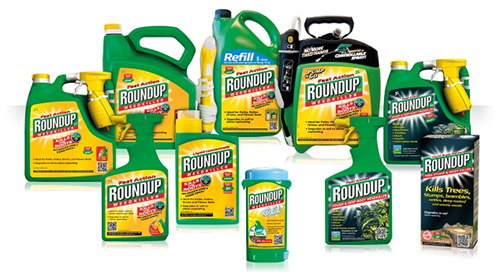
Monsanto, the maker of
Roundup herbicide, is hiding the truth about the dangers of glyphosate, the
active ingredient in Roundup, and trying to paint a picture of it being
essential for agriculture and feeding the world without any harmful impact
on the environment or our health. It is so safe, they claim, that it can be
used in residential areas. Nothing could be further from the truth.
Monsanto, has falsified data on
Roundup’s safety, and marketed it to park departments and consumers claiming
it to be "environmentally friendly,” "biodegradable," and that it "leaves
the soil clean,” to encourage its use on roadsides, playgrounds, golf
courses, schoolyards, lawns, and home gardens. This claim was recently
challenged in a French court and Monsanto was found guilty of false
advertising.
Dr. Stephanie Seneff, a
research scientist at the Massachusetts Institute of Technology (MIT), says
glyphosate is possibly "the most important factor in the development of
multiple chronic diseases and conditions that have become prevalent in
Westernized societies.” Including, but not limited to, infertility,
gastrointestinal diseases (Crohn’s, colitis, IBS), allergies, cancer,
cardiovascular disease, multiple sclerosis, Alzheimer’s, Parkinson’s, and
autism.1
One of the ways glyphosate
harms our bodies is by killing the good bacteria that inhabit our
gastrointestinal tract. These bacteria are essential for proper digestive
and immune function as well as our overall health. Monsanto has emphatically
claimed that Roundup is harmless to animals and humans because the way it
kills weeds is by interfering with the shikimate pathway—a metabolic process
whereby plants produce amino acids which are essential for plant growth and
development. This process is absent in all animals. That may sound
convincing, but the shikimate pathway is also used by bacteria, fungi, and
algae. Therefore, glyphosate is deadly to soil organisms, degrading the
productivity of our farmland, and to our gut bacteria which are essential to
our health and to the health of all animals. In this way, Roundup is
destroying the health of all humans and animals exposed to this herbicide.
Glyphosate also disrupts enzymatic activity in animals and humans. Certain
enzymes that play a crucial role in neutralizing toxins are deactivated by
glyphosate. This means that environmental chemicals and poisons, including
Roundup, become even more toxic.2
Researchers have found that Roundup itself is even more toxic than
glyphosate alone. The reason for this is that Roundup includes other
chemicals besides glyphosate. One of these is a surfactant, TN-20, which
greatly enhances the toxic effects of glyphosate. Animal studies have shown
that the combination of TN-20 and glyphosate leads to cell damage,
degeneration, and death at concentrations where neither substance working
alone would show this effect.3
In humans, prolonged skin
exposure to glyphosate-surfactant herbicide has been shown to produce local
swelling, blistering, and exuding wounds, followed by neurological
impairment and reduced nerve function. It is apparent that Roundup is not as
safe as Monsanto claims it to be.
It’s Not Just in the Food
Since genetically engineered
(GE) crops are heavily sprayed with Roundup, they are also heavily
contaminated with it as well. Every time we eat foods containing GE products
we are ingesting glyphosate. What’s even worse is that this poison is
released into the environment where people and animals can be exposed to
much larger doses. The consequences can be staggering.
In Argentina the
introduction of GE crops and pesticide spraying is turning into a nightmare.
Argentine laborer Fabian Tomasi was never trained to handle pesticides. His
job was to keep the crop-dusters flying by filling their tanks as quickly as
possible. "I prepared millions of liters of poison without any kind of
protection, no gloves, masks, or special clothing,” he said. "I didn't know
anything.” For three years, Tomasi was routinely exposed to chemicals as he
pumped pesticides into the tanks of crop-dusters. Now, at the age of 47 he’s
a living skeleton and near death from polyneuropathy, a debilitating
neurological disorder, which has left him wasted and shriveled.
Schoolteacher Andrea Druetta
lives in Santa Fe Province, the heart of Argentina’s soy country, where
agrochemical spraying is banned within 500 meters (550 yards) of populated
areas. But soy is planted just 30 meters (33 yards) from her back door.
Homes, as well as schools in the area, are often exposed to Roundup spray
from planes that come too close and from winds that blow the pesticide their
way. Druetta filed complaints with the city, alleging that several students
fainted when pesticides drifted into their classrooms and that their tap
water is contaminated. She said, a neighbor keeps a freezer of rabbit and
bird carcasses, hoping someone will test them to see why they dropped dead
after the spraying.
After Sofia Gatica lost her
newborn to kidney failure, she filed a complaint that led to Argentina's
first criminal convictions for not following safety regulations while
spraying. But the verdict came too late for many of her 5,300 neighbors. A
government study there found alarming levels of agrochemical contamination
in the soil and drinking water, and 80 percent of the children surveyed
carried traces of glyphosate in their blood.
Argentina is the world’s
third-largest soybean producer, however, the chemicals powering this boom
aren’t confined to just soy but are sprayed on cotton, corn, and other GE
crops. A nation once known for its grass-fed beef has undergone a remarkable
transformation since 1996, when Monsanto promised that adopting its GE seeds
and chemicals would increase crop yields and lower pesticide use. Today,
Argentina’s entire soy crop and nearly all its corn and cotton are
genetically modified, with soy cultivation alone tripling to 47 million
acres (19 million hectares).
Despite Monsanto’s claim
(i.e, lie) that GE seeds would reduce pesticide use, it has dramatically
increased it (to the benefit of Monsanto, which sells both the GE seed and
the pesticides). Pesticide use in the country increased from just 9 million
gallons in 1990 to more than 84 million gallons by 2013. Overall, Argentine
farmers apply an estimated 4.3 pounds of pesticides per acre, more than
twice what US farmers use.
The spray drifts into
schools and homes and settles over water sources; farm workers mix poisons
with no protective gear; villagers store water in pesticide containers that
should have been destroyed.
Growing Health Problem
Now doctors are warning that
uncontrolled pesticide applications could be the cause of growing health
problems among the 12 million people who live in the South American nation’s
vast farm belt.
In Santa Fe, cancer rates
are two to four times higher than the national average. In Chaco, birth
defects have quadrupled in the past decade since spraying become more
prevalent.
"The change in how
agriculture is produced has brought, frankly, a change in the profile of
diseases,” says Dr. Medardo Avila Vazquez, a pediatrician and neonatologist.
"We've gone from a pretty healthy population to one with a high rate of
cancer, birth defects, and illnesses seldom seen before.”
Molecular biologist Dr.
Andres Carrasco at the University of Buenos Aires says the use of glyphosate
pesticides (Roundup) is worrisome and could spell trouble for human health.
He found that injecting a very low dose of glyphosate into embryos can
change levels of retinoic acid, causing the same sort of spinal defects in
frogs and chickens that doctors increasingly are registering in communities
where farm chemicals are used.
Retinoic acid, a form of
vitamin A, is fundamental for keeping cancers in check and triggering
genetic expression, the process by which embryonic cells develop into organs
and limbs.
"If it’s possible to
reproduce this in a laboratory, surely what is happening in the field is
much worse,” Carrasco said. His findings, published in the journal
Chemical Research in Toxicology in 20104, were rebutted
by Monsanto. "Glyphosate is even less toxic than the [insect] repellent you
put on your children’s skin,” said Pablo Vaquero, Monsanto’s corporate
affairs director in Buenos Aires. Tell that to Fabian Tomasi who lays in a
bed at home dying from exposure to the pesticide; or to Andrea Druetta whose
students fainted when exposed to wind-blown spray; or Sofia Gatica whose
infant died of kidney failure after exposure; and to all the dead rabbits
and birds littering the fields after spraying.
In response to soaring
complaints, Argentina’s President, Cristina Fernandez, ordered a commission
in 2009 to study the impact of agrochemical spraying on human health. Its
initial report called for "systematic controls over concentrations of
herbicides and their compounds...such as exhaustive laboratory and field
studies involving formulations containing glyphosate as well as its
interactions with other agrochemicals as they are actually used in our
country.” But the commission hasn’t met since 2010, the auditor general
found. Some have speculated that the members of the commission have been
bribed to sit back and do nothing. In the meantime, Monsanto earns millions
of dollars in seed and pesticide sales.
Be aware: Natural does not mean Organic
on product labels!
How Tropical Oils Can Protect Us
The most common GE crops in
the US, Canada, and elsewhere are soybeans, corn, canola, and
cottonseed—all of which are used to make editable oils. The cooking
oils, shortenings, and margarines you purchase at the grocery store, the
oils used in most all of the packaged, canned, and frozen foods you buy,
and the oils used in the vast majority of restaurants come from GE
crops. The oils in our diet are the most prevalent source of GE foods in
our diet.
In the US and many other
countries there currently are no laws that require food manufacturers to
identify on the labels of their products that they contain GE
ingredients. How do you avoid these oils? One way is to purchase
"certified organic” products. Organically raised crops, by definition,
are those that have been raised and processed without exposure to
pesticides and other chemicals. Since GE crops are designed specifically
to withstand heavy doses of pesticides, they are naturally heavily
sprayed. Therefore, no GE ingredients should be in a certified organic
product. Be aware that the word "Natural” on a label does not mean
organic. This term has no official meaning, so any product can use the
word "Natural” regardless of where the ingredients come from or how they
are produced.
If you are mindful of the
types of fats and oils you use, you can avoid all of the oils that are
tainted with GE ingredients, even if the product is not certified
organic. Oils that are safe to use include extra virgin olive oil,
avocado oil, macadamia nut oil, coconut oil, palm oil (including red
palm oil), and palm kernel oil. These oils are not derived from GE
sources and are completely safe to use. Many of them, like coconut oil
and palm oil, are generally organically grown, and therefore, free from
pesticide residue, even if they are not labeled "organic,” since they
are often produced by farmers who do not use any pesticides or
chemicals.
It is sad that the people of
Argentina and other countries that grow GE crops are suffering from the
effects of the chemicals used in modern biotech farming. Instead of
growing soy, corn, canola, or cottonseed, they could be growing coconut
or palm, which are not genetically engineered, vastly more
environmentally safe, and far healthier. All commercially available
brands and types of coconut and palm oil are GE free.
References
1. Samsel, A. and Seneff, S. Glyphosate’s
suppression of cytochrome P450 enzymes and amino acid biosynthesis by
the gut microbiome: pathways to modern diseases.
Entropy 2013;15:1416-1463.
2. Gasnier, C., et al. Glyphosate-based herbicides are toxic and
endocrine disruptors in human cell lines.Toxicology
2009, 262, 184–191.
3. Kim, Y.H, et al. Mixtures of glyphosate and surfactant TN20
accelerate cell death via mitochondrial damage-induced apoptosis and
necrosis. Toxicol. In Vitro
2013, 27, 191–197.
4. Paganelli, A, et al. Glyphosate-based
herbicides produce teratogenic effects on vertebrates by impairing
retinoic acid signaling. Chem Res
Toxicol 2010;23:1586-1595.
The Shocking Truth About Palm Oil
by Dr. Bruce Fife
Available from Piccadilly Books, Ltd.
The Truth about
Palm Oil and the Environment
The media
broadcasts alarming stories about the destruction of tropical rainforests
and wildlife for the planting of oil palm. We are encouraged to boycott
products containing palm oil and choose more environmentally friendly
products such as soybean or canola oils. But are these oils any better?
What’s the truth?
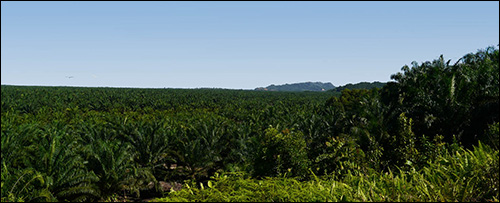
The Oil Palm is
Environmentally Friendly
Palm cultivation
is perhaps, the world’s most environmentally friendly commercial crop. After
oil palms reach maturity they are commercially productive for at least a
quarter of a century. That means that once the trees are planted, the soil
remains essentially undisturbed for decades. Unlike soy and other crops,
were the ground is dug up and recultivated every year, year after year. The
soil in a palm plantation remains essentially undisturbed. Native grasses
and foliage are allowed to repopulate the space between trees. Much of the
natural habitat returns. An oil palm plantation becomes a forest, filled
with vegetation and wildlife. Since the ground is continually covered with
trees and growth, the soil is not eroded, maintaining the integrity of the
environment from the tiniest soil organisms to the largest land animals. So
a palm plantation blends into the environment without causing untold
disruption.
Palm is the
world’s most efficient oil-bearing crop in terms of land utilization,
efficiency, and productivity. Unlike most other crops that produce once a
year, oil palms produce fruit year round, so it is always in season. This
allows for a high yield of fruit on comparatively little acreage. For this
reason, the oil palm produces more oil per acre than any other vegetable
source. For example, in 1 year on one acre of land a farmer can produce 18
gallons of corn oil, or 35 gallons of cottonseed oil, or 48 gallons of
soybean oil. However, on the same amount of land he can produce 635 gallons
of palm oil! In terms of land use, you would need to plant 13 acres of soy
or 35 acres of corn to produce an equal amount of oil from just 1 acre of
palm.

Soybean
cultivation requires 13 times more land to produce the same amount of oil.
Corn requires 35 times as much land. And this land is stripped of all other
vegetation, and continually plowed and replowed, and poisoned with
pesticides. On the other hand, oil palms are planted once and then the land
is allowed to return mostly to its natural state without harming the
environment. Soy, corn, and other crops are often genetically modified so
that they can withstand enormous amounts of pesticides that poison the
environment. Genetically modified crops themselves are adversely affecting
the environment and the health of animals and people that eat these corps.
In contrast, oil palm is not genetically modified so it is not sprayed with
tons of pesticides.
Palm production
also helps protect against global warming. Total area globally devoted to
oil palm production is 9.16 million hectares (35,367 sq miles). Total land
area under soybean cultivation is 92.54 million hectares (357, 299 sq
miles), more than ten times that of oil palm, yet oil palm releases nearly
ten times more oxygen into the atmosphere and absorbs nearly ten times more
carbon dioxide (a major contributor to global warming).
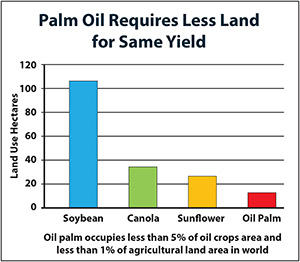
by Dr. Bruce Fife
Available from Piccadilly Books, Ltd.
People voice
concern about forests being cut down to plant oil palms. However,
worldwide more rain forests are being destroyed for soybean production
than has ever been cleared for palm production. Approximately 5,000
square miles of rain forest is leveled in the Amazon each year, most of
it for soybean cultivation. Some people might look at this and say, but
places like Malaysia (one of the world’s biggest palm oil producers)
also converts rain forest into farmland. However, in the past four
years, more Amazon rain forest in Brazil has been destroyed to make room
for soybean cultivation than Malaysia has cleared in the past 100 years
for palm oil production. In comparison to soybean and other oil crops,
palm oil is by far the most environmentally friendly.
The Misguided
War on Palm Oil
In an attempt
to demonize palm oil, articles describing the deforestation of tropical
rainforests always infer that the sole purpose for the destruction being
caused is for palm oil plantations. This is far from the truth and is
very deceptive and misleading. Logging is the primary reason for most of
the deforestation that is occurring in these areas. It is the desire for
lumber that is leveling the forests. Once the land has been cleared of
trees it is now open and available for agriculture. Any agricultural
business can then come in and buy up the land for cultivating pineapple,
bananas, sugarcane, soybeans, oil palm, and other crops. Environmental
activists in their overzealous effort to demonize oil palm, ignore all
these other industries and focus solely on oil palm giving a false
picture of what is really going on.
Environmental
activists would have you believe that the world would be a far better
place without palm oil around. They encourage boycotting palm oil in the
belief that it would drive the palm oil produces out of business and
palm plantations would revert back to forest...Let’s just suppose these
activists got their way, and all the demand for palm oil tanked out and
the people ceased to buy palm oil, what would happen?
It would
trigger an environmental disaster! Soybean cultivation is palm oil’s
biggest competitor. Soybean oil is the second most produced oil in the
world, just behind palm oil. If palm oil suddenly disappeared, there
would be a huge demand for oil worldwide. Another product would be
needed to fill the void. What product do you think will do this?
Obviously, soybean oil, along with canola and corn oils.
Why would this
be bad for the environment? If you took all the oil palm plantations and
converted them over to producing soybean oil, there would still be a
major deficit of oil on the market. Keep in mind that it takes 13 acres
of soy to equal the output of just 1 acre of palm oil. Therefore, an
additional 12 acres of land must be deforested in order just to maintain
current demand for oil. The demand for oil will drive soybean and other
vegetable oil producers to acquire more land by any means available to
them, this means much of it will come from native forests, including
these in the Amazon, Indonesia, and Malaysia and elsewhere. Forest
destruction would accelerate beyond anyone’s imagination. It would be an
environmental disaster. That is just due to the deforestation of land
needed to meet the current demands from the market.
The oil crops
that will take the place of oil palm will be soybean, canola, corn, and
other genetically modified crops that are specially engineered to
withstand enormous loads of environment-destroying pesticides. In
addition, the land itself will be dug up and plowed, all native
vegetation will be destroyed to make room for the new crops. Animals
will be driven from their homes or killed, like never before. The soil
will be altered by synthetic fertilizers, changing the ecology of the
microorganisms and the land forever.
The only thing
that the activists would accomplish, is destroying more of the
environment than ever before—killing more animals, cutting down more
forest, poisoning more land, and (this the big one) enriching the
soybean and seed oil industries with insane profits. Do you think the
executives controlling the seed oil industry are ignorant of the huge
financial gain that awaits them if their major competitor went out of
business? Not on your life. The environmental issue is a fabrication
designed by the bigwigs in the seed oil industry as a means to take over
the palm oil market. They are fueling the fire with lies, half-truths,
and misconceptions that they funnel to special interest and green groups
in order to motivate them into being unwitting vocal allies to this
monstrous scheme.
If activists
are really concerned about the environment, they would not waste their
time fighting the oil palm industry, they would focus on the real threat
to the environment—the soybean and seed oil industries. Yet, we rarely
hear about the harm soybean cultivation is causing the earth—far more
than the oil palm ever did—but hardly a word is said. You don’t see
websites devoted to stopping logging in forests that are converted over
to soybean production. You don’t hear much about all the environmental
destruction caused by the cultivation of genetically engineered soy,
canola, and corn.
Reducing the
demand for soy and seed oils with oil palm would greatly improve the
environment. So where are all the people campaigning to save us from the
soy industry? The campaign against oil palm is a contrived issue
perpetuated by the soy and seed oil industries as an attempt to take
over the oil palm market. Please do not be deceived by clever marketing
tactics that attack palm oil for destroying rainforests and wildlife.
Palm oil production is far more environmentally friendly than any of the
seed oils.
Do you have friends who would like this newsletter? If so, please feel free to share this newsletter with them.
If this newsletter was forwarded to you by a friend and you would like to subscribe, click here.
Copyright © 2016, Bruce Fife. All rights reserved.
